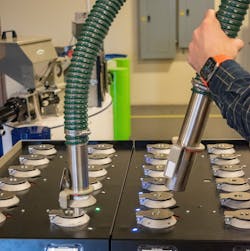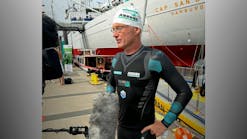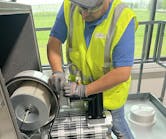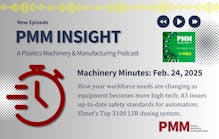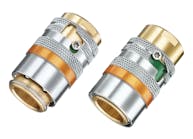Auxiliary makers prioritized medical orders during pandemic
By Bruce Geiselman
The market for plastics in medical devices is substantial and growing, Chris Weinrich, director of packaging and medical for Conair, told attendees of the Conair Summit 2021, an online conference held May 18-20.
Representatives of Conair, Dri-Air and Moretto discussed trends in the industry, new products, and how their companies responded to changing customer demands during the COVID-19 pandemic.
“Domestic and global demographics, including a growing middle class, an increased life expectancy and overall population increase around the globe, all point toward signs of a continued increase in the need for medical devices,” Weinrich said.
Conair sees three general trends in injection molded and extruded medical components, he said. First, customers are looking for reduced product development life cycles to improve their speed to market. Second, specialty materials and additives are increasing in popularity. Third, customers are demanding tighter product tolerances.
“While I expect none of these are surprising trends for you and not unique to the medical market as we see them occurring in other markets as well, they do create some opportunities for plastics auxiliary equipment,” Weinrich said. “Conair has been working on products and processes to support our customers in meeting these trends within their medical molding and extrusion operations.”
At the onset of the pandemic in 2020, Conair’s business across all markets fell, Weinrich said. However, the medical device market picked up activity quickly as customers adapted to the immediate need for specific equipment including PPE and respiratory care devices.
“Many companies ramped up production to offset the shortages,” Weinrich told Plastics Machinery & Manufacturing. “In many cases, we prioritized those orders in order to shorten equipment lead times as much as possible. We also sold existing lab equipment to support our customers.”
One example Weinrich cited was a Conair customer who expanded to start manufacturing COVID-19 test kits. That expansion required the purchase of more than 50 of Conair’s press-mounted SlimLine model dryers, he said.
“This is almost four times the volume we typically sell in a year of this product,” Weinrich said during the conference.
Another customer required a new extrusion line to increase production of IV tubing, and Conair’s Michigan plant coordinated the planning and production of the auxiliary equipment for delivery 10 weeks ahead of schedule, he said.
The demand for shortened lead times during the pandemic is an example of a general trend among Conair’s customers to reduce product development life cycles, he said.
Another trend is the use of materials such as PEEK and polytetrafluoroethylene, which are processed at much higher temperatures than traditional materials. Additives, such as antimicrobials, also have an impact on equipment selection.
Conair’s development labs, including a state-of-the-art Michigan facility with four extrusion lines, can help clients using new materials or specialty additives determine changes to processing parameters, such as drying temperatures, tooling sizes, cooling rates, puller speeds and methods of cutting or coiling the finished product, Weinrich said.
“The lab is equipped with equipment and experienced processing experts to test and define new parameters for successful production,” Weinrich said.
New Conair equipment helps meet demands
Conair recently added several new pieces of auxiliary equipment that can help medical processors meet new challenges.
“For extremely accurate feeding at very low rates, Conair has recently added to our TrueFeed line of gravimetric feeders our TrueFeed Micro Feeder,” Weinrich said.
The Micro Feeder can dose expensive additives at a controlled rate as low as one pellet per shot or a maximum rate of five pellets per second.
“It’s ideal for small-scale lab applications, pharma applications and micromolding processes,” Weinrich said.
Conair last year introduced TrueRate, a sensing device that uses the latest weighing technology to convey or dose an exact amount of resin to a destination. It can calculate and display the weight for each load cycle and tabulate running throughputs, Weinrich said. It also can display total usage by shift or any other time period.
“We have also been hard at work developing new drying technology that is great for the medical device market,” Weinrich said. “In addition to our MicroWheel dryers that are well-suited for clean rooms and mounting directly on extruder feeder throats, Conair introduced last year our Multi-Hopper Cart. This mobile drying system is ideal for clean rooms and plants requiring frequent material changes.”
Each cart can have as many as four drying hoppers, and the carts can be coupled together to use a single larger dryer.
Another new product is Conair’s Resin Selection Station radio-frequency identification (RFID) technology.
“It provides flexibility to convey any material to any destination, but the RFID proofing eliminates sending the wrong material to a destination,” Weinrich said. “It incorporates our new SmartFLX control as the user interface. Both the SmartFLX HMI and selection station use color-coded LED indicators to show connection status.”
The technology prevents a receiver from turning on unless a proper material source connection is established. The system, which becomes available this summer, can prevent costly mistakes, Weinrich said.
Conair last year also introduced a new coil strapping system for its ATC Series of tube coilers, which are dual-spindle coilers for all types of medical tubing ranging from 0.02 inch up to 0.5 inch in diameter at line speeds of up to 800 feet per minute, Weinrich said.
“This coiling of the product is accomplished with little to no winding tension,” Weinrich said. “The automatic strapping option securely straps finished coils for handling with FDA-compliant PET strapping. This is great for low-friction tubing that tends to unwind off its core.”
The new coil strapping system also is available for retrofit on existing coilers already in production.
Moretto dryers handle technical resins
In mid-2020 Moretto began introducing into the U.S. market its X Comb line of resin dryers, which the company says is the latest addition to the range of high-performance mini dryers for the dehumidification of technical materials.
The X Comb XD 12-18 series is designed for demanding applications including medical applications. X Comb dryers are particularly well-suited for clean room settings because the air used for regeneration of the desiccant can be vented outside the clean room, said Gene Flockerzi, GM of Moretto USA, the U.S. arm of Moretto SpA, Massanzago, Italy.
A continuously rotating honeycomb of zeolite desiccant provides simultaneous resin drying and desiccant regeneration.
X Comb models are most suitable for drying engineering-grade resins at throughputs from 3 to 44 pounds per hour, depending upon the resin, according to the company. They include an advanced color touch-screen control for easy programming and a viewer for dryer status and actual drying temperature.
Processors of plastics for medical applications also like the dryers because they provide accurate heat and dew point control, which are important when working with technical materials, Flockerzi said.
“They all have the variable frequency drive technology, which enables our customers to, instead of having to fluctuate temperature … modulate how much air is going into the hopper,” Flockerzi said. “You’re keeping consistent throat temperatures all the time.”
The dryers, during their relatively short time of availability in the U.S., have proven popular, and contributed to a strong year of sales despite the pandemic, Flockerzi said.
“Our sales have increased significantly,” he said. “We had our best year ever in 2020, even though there were adverse market conditions … It seems that with the small dryers, people need them, and they need them now, especially with the COVID situation. We were very fortunate to have a lot of stock on the shelves ready to go, so we didn't have to worry about supply chain issues with getting product into the United States.”
The demand was fueled in part by a need for catheters and other medical parts. Moretto saw increased sales across the U.S., but especially in California and the Midwest, Flockerzi said.
Dri-Air supports COVID-19 response
Dri-Air Industries designs and sells customized systems for drying and conveying resin, including systems for producers of medical tubing and other medical products. The company's conveying systems can transport resin to dryers and then convey the dry resin to the feed throats of extruders or injection molding machines.
The company experienced an increase in sales to medical processors during the pandemic, which helped offset declines in equipment demands from the automotive industry and other industries, said Jason Sears, Dri-Air president.
“What happened was that as you saw the medical molding increase, you also saw the decrease of automotive; you saw the decrease of a lot of the different industries all while medical was booming,” Sears said. “If you looked back at April of last year, people were scrambling for masks, people were scrambling for shields, everybody was trying to do their part to solve the pandemic, whether it was preventative or diagnosing or cures.”
Sears said he and his employees felt like part of the solution to the pandemic. In order to help medical professionals, Dri-Air developed a system that prioritized orders for equipment that would be used in fighting the disease.
“When COVID-19 happened last year, one thing that we created was COVID-19 production,” Sears said. “Any orders that came in that were COVID-19 projects were earmarked with a red cross on the order so that everybody within the facility knew that this was a COVID project, and all these projects would go in front of any other production. Any COVID projects, we were trying to push them out within a week to a week and a half.”
Customers were developing test kits and swab kits and parts and tubing for ventilators, and those projects got moved to the front of the line, Sears said.
The number of medical projects has started dropping back to pre-pandemic levels. However, the company currently is developing a custom conveying and drying system for use with a clean room where medical equipment will be produced.
“We are able to build equipment to satisfy a particular application,” Sears said.
The customer wants to convey material out of 12 drying hoppers for a distance of about 120 feet going through a wall and into a clean room, where there are six receivers.
The system will convey expensive, highly engineered resins for medical devices, meaning the customer wants to convey only small shots of resin at a time, something many conveying systems are incapable of doing.
“We are conveying 50 grams of material to a receiver,” Sears said. “Fifty grams is probably a handful of material. In most systems, you can’t convey that small amount of material, never mind clean/purge the line out so that there is no material left in the line. Most medical molders are molding an expensive material, something that’s FDA-approved, so their materials are more expensive than some other materials you’re going to find.”
Medical molders may only use one pound of material for an entire day, so they don’t want a lot of conveyed material sitting in the feed throat of an injection molding machine where it would be exposed to ambient conditions and potentially absorb moisture.
“This [system] is going to dose a small amount of material, convey it, and clean out the line so there is no residual material in the lines,” Sears said.
In addition, the majority of the material handling and the drying process will take place outside of the clean room, which also keeps dust out of the clean room.
The multiple hopper bank system was designed to automate the drying and conveying processes, Sears said. By designating specific hoppers for each receiver, it will be easy for the customer to maintain lot traceability for resins.
The system is composed of two hopper banks with six hoppers each. Each bank is dedicated to a specific lot of material, which can be conveyed to six receivers, where each receiver is dedicated to a press. This provides easy lot traceability and built-in redundancy as each hopper bank has its own dryer, Dri-Air said.
Dried materials in the hoppers are metered into the conveying system using pocket valves, Sears said. By gravimetrically dosing a small amount of resin, starting at about 50 grams, into the conveying system, the lines can be easily purged clean every cycle. Resin dispensing and purging times are adjustable through two full-color HMIs. One HMI is attached locally to the pump package in the materials room and the second HMI is located in a remote clean room for operator convenience.
The remote HMI provides a duplicate set of controls for all of the conveyance functions and alarms of the main screen.
Dri-Air’s DP-501 closed-loop loading system transports the dry material over 120 feet to each receiver using dry air, preventing outside moisture from migrating into the freshly dried and conveyed material.
For operational redundancy, a backup pump provides a second vacuum source. The closed-loop loading control package allows the operator to manually designate which blower package to use, or the backup pump will operate automatically in case of blower failure.
Bruce Geiselman, senior staff reporter
Contact:
Conair Group, Cranberry Township, Pa., 724-584-5500, www.conairgroup.com
Dri-Air Industries Inc., East Windsor, Conn., 860-627-5110, www.dri-air.com
Moretto USA LLC, Jackson Center, Pa., 724-269-7600, www.moretto.com
More on medical parts and plastics
Parts makers step up their processes to meet needs
Health-care market keeps IMM makers busy
Injection unit, machine dedicated for test tubes among new processing technologies
Extruder OEMs respond to changing medical landscape
Robots shine in clean room duties
Economist: Run on medical goods provided jolt to plastics manufacturers
University speedily designs and prints nasal swabs
Geisinger’s 3-D lab printed devices to help health care workers stay safe
Beckwood Press designs compression molding equipment for medical devices
Quick deliveries, new products: Husky details COVID-19 response
Bruce Geiselman | Senior Staff Reporter
Senior Staff Reporter Bruce Geiselman covers extrusion, blow molding, additive manufacturing, automation and end markets including automotive and packaging. He also writes features, including In Other Words and Problem Solved, for Plastics Machinery & Manufacturing, Plastics Recycling and The Journal of Blow Molding. He has extensive experience in daily and magazine journalism.

